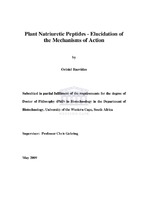| dc.contributor.advisor | Gehring, Chris | |
| dc.contributor.author | Ruzvidzo, Oziniel | |
| dc.contributor.other | NULL | |
| dc.contributor.other | Faculty of Science | |
| dc.date.accessioned | 2014-01-29T13:47:30Z | |
| dc.date.available | 2010/09/30 17:28 | |
| dc.date.available | 2010/09/30 | |
| dc.date.available | 2014-01-29T13:47:30Z | |
| dc.date.issued | 2009 | |
| dc.identifier.uri | http://hdl.handle.net/11394/2659 | |
| dc.description | Philosophiae Doctor - PhD | en_US |
| dc.description.abstract | Several lines of cellular and physiological evidence have suggested the presence of a novel class of systemically mobile plant molecules that are recognized by antibodies generated against vertebrate atrial natriuretic peptides (ANPs). Functional characterization of these immunoanalogues, referred to as immunoreactive plant natriuretic peptides (irPNPs) or plant natriuretic peptides (PNPs), has shown that they play important roles in a number of cellular processes crucial for plant growth and maintenance of cellular homeostasis. Although the various biological roles of PNPs in plants are known, their exact mode of action remains elusive. To elucidate the mechanisms of action for these immunoanalogues, we have prepared a biologically active recombinant PNP from Arabidopsis thaliana (AtPNP-A) and the biological activity was demonstrated by showing its ability to induce water uptake into Arabidopsis thaliana protoplasts. In addition, the molecule was shown to downregulate photosynthesis while at the same time up-regulating respiration, transpiration as well as net water uptake and retention capacities in the sage Plectranthus ecklonii. Further analysis of the recombinant AtPNP-A indicated that the peptide can induce systemic response signalling though the phloem. A recombinant Arabidopsis wall associated kinase-like protein (AtWAKL10) that has a domain organization resembling that of vertebrate natriuretic peptide (NP) receptors was also partially characterized as a possible receptor for the recombinant AtPNP-A. Vertebrate NP receptors contain an extracellular ligand-binding domain and an intracellular guanylate cyclase (GC)/kinase domain and signal through the activity of their GC domain that is capable of generating intracellular cGMP from GTP. The structural resemblance of AtWAKL10 to vertebrate NP receptors could suggest a functional homology with receptor molecules and it is conceivable that such a receptor may recognize PNPs as ligands. The characterization of the recombinant AtWAKL10 showed that the molecule functions as both a GC and a kinase in vitro. This strengthened the suggestion that AtWAKL10 could be a possible AtPNP-A receptor especially considering the fact that AtPNP-A applications to plant cells also trigger cGMP transients. Furthermore, a bioinformatic analysis of the functions of AtPNP-A and AtWAKL10 has inferred both molecules in plant pathogen responses and defense mechanisms, thus indirectly functionally linking the two proteins. | en_US |
| dc.language.iso | en | en_US |
| dc.publisher | University of the Western Cape | en_US |
| dc.subject | Five classical hormones | en_US |
| dc.subject | Regulatory peptides | en_US |
| dc.subject | Natriuretic peptides | en_US |
| dc.subject | Plant natriuretic peptides | en_US |
| dc.title | Plant natriuretic peptides - elucidation of the mechanisms of action | en_US |
| dc.type | Thesis | en_US |
| dc.rights.holder | University of the Western Cape | en_US |
| dc.description.country | South Africa | |

